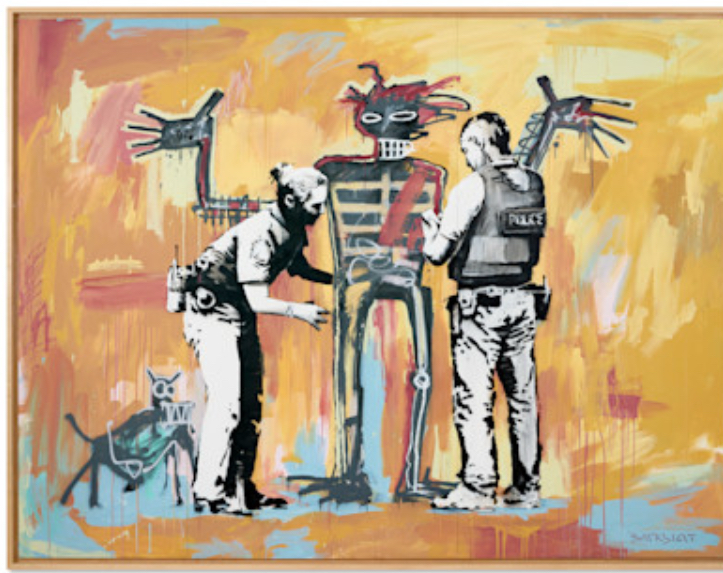In the often provocative world of Banksy, no piece strikes quite the same balance of whimsy and critique as Stop and Search. Created in 2007 and attributed to the elusive British street artist born in 1974, the artwork has become a notable entry in both cultural discourse and art investing platforms. While it captures a laugh at first glance, the message hits deeper—especially in today’s climate of surveillance, over-policing, and civil liberty erosion.
Banksy’s work frequently tackles the hypocrisy of institutions—government, police, capitalism—with dark humor and biting irony. Stop and Search is a perfect example: in it, the innocent figure of Dorothy from The Wizard of Oz is seen being searched by a police officer, her dog Toto looking on as her woven basket is rifled through. It’s ridiculous. And that’s the point.
A Storybook Character Meets Real-World Scrutiny
Dorothy represents pure Americana. She’s a symbol of childhood, imagination, and moral clarity. Placing her in a situation where she’s subjected to a routine stop-and-search turns the viewer’s expectations inside out. The image feels invasive—like something is deeply wrong. Why is this innocent character being treated like a criminal?
That discomfort is the trigger. Banksy wants you to feel the contradiction. The sweetness of the original Wizard of Oz story is weaponized to critique real-world policies, especially the UK’s controversial stop-and-search powers, which have long been criticized for targeting ethnic minorities and younger citizens disproportionately.
The idea that anyone can be stopped, questioned, and searched at random is rendered absurd by using someone as harmless as Dorothy. She’s not a threat. She just wants to get home.
The Visual Elements: Humor with a Sharp Edge
Visually, the piece is classic Banksy. It’s mostly monochrome, except for small color highlights—most notably the blue of the police officer’s latex gloves. That contrast pulls focus to the search itself, almost fetishizing the intrusion.
Toto, Dorothy’s loyal dog, stands nearby, watching with a helpless expression. His presence intensifies the awkwardness. It humanizes the moment, subtly suggesting that witnesses to power abuse are often just as stunned as the victim.
There’s no background—just a flat, empty space—which makes the figures feel like cutouts placed into your personal space. It’s a technique Banksy often uses to strip away context and leave nothing but the idea. The starkness is deliberate. It says, “Look here. There’s nothing else.”
The Political Message: Satire Meets Surveillance
When Stop and Search was first released in 2007, the UK’s stop-and-search laws were under fierce debate. In the post-9/11 world, many Western countries had introduced heightened security measures. But critics argued they disproportionately affected the wrong people, often based on appearance rather than behavior.
Banksy’s commentary wasn’t subtle: how far can these laws go? If we’re now searching cartoon girls from Kansas, what exactly are we protecting?
But the piece goes beyond UK politics. It’s a universal metaphor for overreach. In any country, at any time, when governments blur the line between security and intrusion, the results can look as absurd—and disturbing—as this image.
Limited Edition and Cultural Value
Only 500 signed prints of Stop and Search were released, making it a highly sought-after piece in the Banksy collector’s market. It has since been featured in galleries, private collections, and prominently on art investment platforms like Masterworks, where contemporary pieces are turned into fractional investment opportunities.
Its presence on Masterworks is telling. It signifies how Banksy’s art—while subversive—is also a serious commodity. The paradox isn’t lost on anyone: a critique of police power and systemic scrutiny is now a high-value, securitized asset. That tension between message and market only strengthens the intrigue surrounding Banksy’s work.
The Banksy Effect: Humor as a Trojan Horse
Banksy has long used familiar characters and tropes to open deeper discussions. By drawing on pop culture or childhood imagery, he lowers the viewer’s defenses. Then he inserts discomfort.
Stop and Search isn’t as confrontational as some of his works—it doesn’t depict violence or war—but it may be more effective because of its subtlety. There’s no blood, no protest signs, no slogans. Just a girl and her dog being inconvenienced by a faceless authority figure. But the absurdity gets under your skin.
That’s the magic trick. He’s not telling you what to think. He’s making you ask: why does this feel wrong? Why does this image, simple as it is, make me question the systems I take for granted?
Legacy and Relevance
Nearly two decades after its release, Stop and Search still resonates—maybe even more so. The issues of surveillance, civil rights, and state authority haven’t gone away. If anything, they’ve deepened.
Social movements like Black Lives Matter have further challenged how police forces operate and who they target. Technology has introduced new forms of surveillance, from facial recognition to predictive policing. In that context, Banksy’s image feels prophetic. It’s not about a specific policy anymore—it’s about power, and who has the right to question it.
Thoughts
Stop and Search is more than just a cheeky image of Dorothy getting searched—it’s a masterclass in visual satire. It invites viewers into a moment of absurdity and leaves them with serious questions about authority, security, and freedom.
For collectors, it’s a prized asset. For casual viewers, it’s a conversation starter. For Banksy, it’s another example of how to use a stencil, a little humor, and a lot of truth to spark reflection.
No comments yet.








